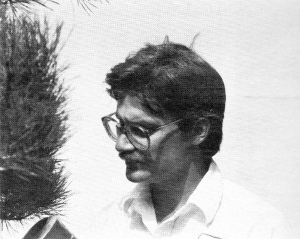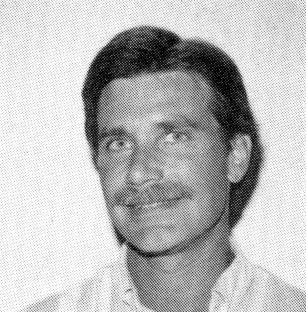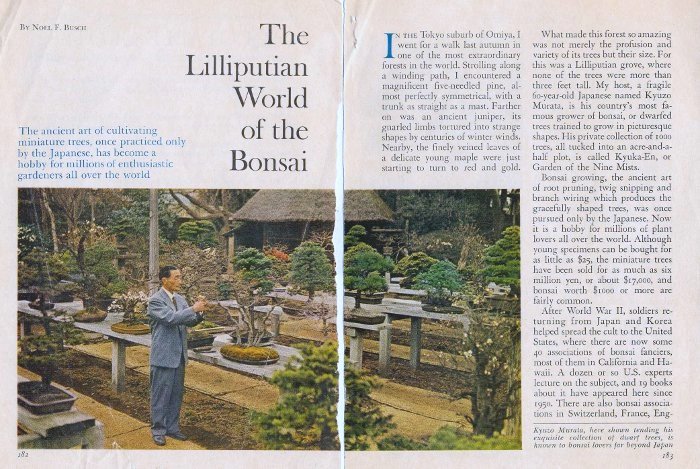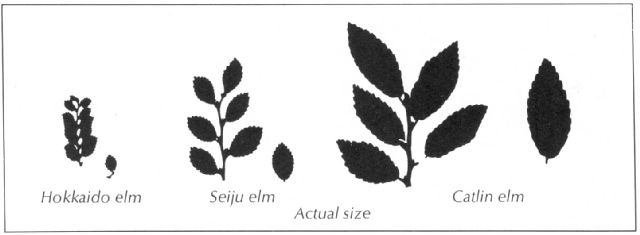| 21 |
|
||||
| 22 |
1878 -- Shigeru was born in Tokyo as the fifth son of the civil rights activist Tsuna
Takenouchi of Tosa. His mother was rumored to be a geisha. [The boy would be sent to live
with the childless Yokohama industrialist Kenzo Yoshida and his wife, who later would adopt him and provide
him with a good education and a sizeable inheritance. Shigeru Yoshida would go on to be a diplomat,
statesman, and major prime minister in Japan during the Allied Occupation. When the Nippon Bonsai
Association was established in 1965, he would be its first president.]
("Historical Figures,"
http://www.ndl.go.jp/constitution/e/etc/figures.html;
Morita, Kazuya and NBA Editorial Staff "Bonsai in Japan," in Tsukiyama, Ted T. (ed.) Bonsai of the World, Book
I (Japan: World Bonsai Friendship Federation, 1993), pg. 89) SEE ALSO: Oct 20
1918 -- Dorothy S. Young was born. [Running one of the first bonsai nurseries on the east coast with her husband Luther, she would go on to become one of the founders and presidents of The American Bonsai Society and the first editor for its Journal.] (SSN Master File by Birthdate) SEE ALSO: Mar 1 1976 -- The Club Peruano de Bonsai was founded on Jorge Lucero's visit to Lima, Peru during his second bonsai lecturing tour of South America. This particular tour started in Caracas, Venezuela, where he had organized the visit of grandmaster John Naka to that city. (Lucero was also instrumental in the formation of the Club Venezolano de Bonsai, in Caracas that year, and the Sociedad Conservacionista y de Bonsai, in Valencia, Venezuela the next year.) He was John's assistant during his presentations there. John was to return to the U.S. after the visit to Venezuela and Jorge would continue his bonsai lecturing tour to Colombia, Peru, Bolivia, and Argentina. But John, with his wife Alice, were so excited about being in South America that he wanted to come with Jorge after Venezuela to Peru and also visit the ruins of Machu Picchu. (Jorge had planned to do that before starting his tour.) Jorge hastily arranged Naka-san's trip and while the former was in Colombia, the grandmaster went to Peru and to the ruins. They then met in Lima and John observed and participated in Jorge's lectures, demonstration and workshops. The people in Lima did not know Naka-san was coming. On the first day of activities, John and Alice showed up. He introduced himself as "Jorge's Junior Assistant". Needless to say, that group of people was truly excited and all had a great and unforgettable experience. The group could not have afforded to bring John Naka to speak before them at that or at any other time. (John would never manage to get back to Peru, although in later years he would visit Venezuela again and also Colombia. (Personal e-mail from Lucero to RJB Sept 13, 2006) SEE ALSO: Sep 22, Nov 20 1985 -- " Bonsai," a set of four postage stamps, was issued by the Republic of China (Taiwan). SEE ALSO: Jan 23, Jan 29, Feb 3, Feb 16, Mar 1, Mar 27, Mar 31, Apr 3, Apr 6, Apr 18, May 6, May 29, Jun 16, Jul 20, Aug 20, Aug 22, Oct 1, Oct 4, Dec 9. |
||||
| 23 |
1991 -- The premier bonsai master in Hawaii, Haruo "Papa" Kaneshiro, died at age 83.
(Born in Kanegusuku village, Okinawa, Japan in 1908, he went to Hawaii at the age of 13 with his father as part of
a large immigrant work force to work as a field and millhand on sugar plantations along the coast on the Big Island
of Hawaii. In 1925, he moved to Honolulu and worked as a waiter at the Moana Hotel and the Kewalo Inn, where
he met and ultimately married co-worker Masako Uyehara. In 1938, they opened their own restaurant known as the
"Paawa Café" and successfully operated the business until they retired in 1955. Kaneshiro had acquired
and built a number of rental apartments, and upon retiring he took care of his apartments and made bonsai his
"full-time job." Kaneshiro's interest in bonsai commenced after the outbreak of World War II when he obtained a few bonsai from Soboku Nishihira (1903-1979), his old roommate from his plantation days. Nishihira was an energetic entrepreneur who contracted to do dangerous digging and blasting of tunnels through mountains as part of the famed Kohala Ditch. This water system brought water from the Kohala Mountains to allow agriculture to flourish along the Hamakua Coast. Today, it's also part of an eco-tourism kayak adventure. Nishihira was successful, received his contract bonus, and leveraged it into a pig farm in upper Kaumana above the city of Hilo. When World War II broke out after the Dec. 7, 1941 Pearl Harbor attack, it was a fearful time and Japanese books, culture, and treasures were destroyed or hidden. Nishihira collected kitchen waste to feed his pigs and his slop cans hung on posts in the backyards. Occasionally he saw an old, well-trained bonsai tucked away and after seriously discussing the danger of having such symbols of disloyalty waiting to be discovered "by the FBI who would throw you [as a pro-Japan sympathizer] in the calaboose," the owners often agreed to sell them to Nishihira who had a place above Hilo in the forest reserve where "the FBI no come." Other bonsai were either destroyed or planted in the ground. (Kaneshiro had been a part of a real estate investment group that earned windfall profits in land speculation. With some of this money he had opened his restaurant, while Nishihira was able to buy some of the "dangerous" bonsai.) After the war, Nishihira brought his many trees out of the forest reserve, lined them up according to price, and opened the first known Hawaiian bonsai nursery. His home was also frequently visited by Kaneshiro, then a cook on the inter-island Young Brothers barge. When it docked in Hilo, Kaneshiro would visit his friend Nishihira and learned the art and culture of bonsai. Some of the oldest bonsai went to Honolulu with him and soon there was a steady stream of buyers. Because of the ideal weather and granular volcanic media, several Hilo bonsai nurseries started up. Although he learned something about bonsai from Nishihira and he deepened his knowledge by reading Japanese books and absorbing the proper tree forms and styles from picture books, Kaneshiro's skills were mostly self-taught since there were no real bonsai teachers outside of Japan in those days. His "style" evolved due to his way of shaping by wiring and pruning. He was an astute observer of the way a tree sprouted when trimmed and developed his own pruning strategy for each of the many trees that he grew as bonsai. He was very comfortable with the results as he felt that each tree was helping to shape itself. Kaneshiro coupled an innate sense of beauty with sensitive, artistic "bonsai hands" to create and duplicate in miniature beautiful tree forms found in nature. He developed such a close kinship with his bonsai through his deep love for plants that he was able to say: "The trees talk to me and tell me how they should be watered, cared for, and how to be shaped into beautiful tree forms." Kaneshiro shared his bonsai knowledge and talents with legions of bonsai enthusiasts in Hawaii and was affectionately known as "Papa" because he had been a bonsai papa to all of them. What makes him so special in the bonsai world was his kind and generous willingness to share his love and knowledge of bonsai for the greater enjoyment and appreciation by others. He learned bonsai at a time when it was treated as an esoteric cult; training techniques were held as closely guarded secrets. But unlike many of his contemporaries, Papa Kaneshiro willingly shared his knowledge with all who were willing to learn. As a result, many of the leading bonsai practitioners in Hawaii today were taught in their "bonsai careers" by Papa Kaneshiro. Bonsai organizations throughout Hawaii also benefited from his participation and sharing. While being one of the pioneer members of the Japanese-speaking Honolulu Bonsai Kenkyu Club in the 1950s, Papa helped to establish the Hawaii Bonsai Association as an organization dedicated to teaching and promoting bonsai in English and served as its adviser from its founding in 1970 until his death. At the International Bonsai Congress of 1980 held in Honolulu, Papa led the Hawaii bonsai-demonstration team in a then unique three-ring simultaneous demonstration and was honored for his contribution to the advancement of bonsai in Hawaii. In 1984, he was invited to the International Bonsai Congress in Seattle, where he appeared as a featured bonsai demonstrator at that convention. Then, at the 1986 International Bonsai Congress in Washington, D.C., Papa was invited to represent Hawaii and to feature tropical bonsai from the Pacific region. Later in 1986, he led a team of four from Hawaii on a three-week bonsai demonstration tour of Australia. In 1988, he was invited to shape in Japanese black pine at the 25th anniversary celebration convention of the California Bonsai Society in Los Angeles. At the International Bonsai Congress held in 1990 at the Waikiki Sheraton Hotel, Papa Kaneshiro received a Certificate of Merit from the Nippon Bonsai Association. At the same convention, the National Bonsai Foundation announced its plans to name and build the Haruo Kaneshiro Tropical Conservatory adjacent to the John Y. Naka North American Bonsai Pavilion. At the time of death, Papa Kaneshiro had been creating bonsai for almost 50 years, and his landscaped bonsai garden at his home was considered the primary bonsai attraction in Hawaii, featuring a wide variety of tropical trees and plants trained into traditional bonsai forms. One of Papa's bonsai masterpieces, a 31-inch high Japanese black pine, is among the North American bonsai on display at the U.S. National Arboretum. And yet he is more remembered for his spirit of adventure and willingness to experiment. Papa could not care less about "traditional bonsai forms" and he refused to use Japanese bonsai style names. His bonsai reflected each tree's inherent growth structure and while most others in the Hawaiian bonsai community at that time were deliberately training tropical trees into traditional Japanese "pine tree" bonsai styles -- such as banyan trees trained as moyogi (single apex trunk with multiple S-curved trunk and flattened tier branches at the outside of the trunk curves), Papa was amongst the first to train banyan bonsai into a multiple apex-arched branch tropical tree structural forms. Please see this video for an interview with Papa, and this tribute. Also, from 1985, there is this 6-minute (starting at 31:18 to 37:17) Hawaii Public TV segment about Papa's garden. 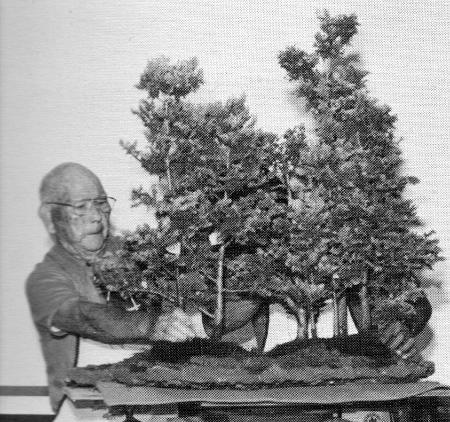
"The final adjustments to this juniper group planting on a
("Haruo 'Papa' Kaneshiro," Bonsai Journal, ABS, Vol. 25, No. 4, Winter 1991, pg. 21; ; "History of the Hawaii
Bonsai Association,"
http://www.hawaiibonsaiassoc.org/files/History.html;
Fukumoto, David W. "Aloha Isamu 'Ham' Kaneshiro!,"
http://www.fukubonsai.com/MPBF1a1.html;
"The Okinawan Contribution to Hawaii Bonsai!,"
http://www.fukubonsai.com/5a28.html;
Elias, Thomas S. "History of the Introduction and
Establishment of Bonsai in the Western World," pp. 68-70; David Fukumoto in personal e-mails to RJB, 8 and 9 Jan 2011;
"Persons born 08 February 1908 in the Social Security Death Master File,"
http://ssdmf.info/by_birthdate/19080208.html) SEE ALSO:
Feb 21, Jul 11, Dec 13
volcanic slab are made by Haruo Kaneshiro and his able assistants [in Seattle in July 1984]." (Bonsai Journal, ABS, Vol. 18, No. 3, Fall 1984, pg. 65) |
||||
| 24 |
1982 -- The National Bonsai Foundation was incorporated under the
Washington, D.C Non-Profit Corporation Act. (Three years after the Bicentennial gift of Japanese bonsai,
Janet Lanman talked to Dr. John L. Creech, Director of the National Arboretum, about the possibility of acquiring
American bonsai. Shortly thereafter Creech pursued the idea in a letter to Marion Gyllenswan: "It really
calls for an independent body of bonsai authorities to look at the overall situation with private collections of
heirloom quality and develop some kind of plan for their preservation, either as part of a national collection or
by local public institutions." Acting on this suggestion, a group of Arboretum volunteers and Yuji
Yoshimura's students organized themselves as the National Bonsai Committee.) [The Board of Directors would
initially meet two months later. The Foundation's first project would be to help develop the design and
nature of and raise funds for an American Bonsai Pavilion.]
("What's Past",
http://www.gwu.edu/~jeffstep/bonsai/nbf/past_prologue/pp_pt1-1.html
; personal e-mail from Felix Laughlin to RJB, May 6, 2002) SEE ALSO: Mar 20, May 2, Aug 7,
Oct 1
2004 -- Scientist, writer, potter, artist, and critic Max Braverman died in Everest, WA a few days before his 75th birthday. ("In Memorium," Bonsai Journal, ABS, Vol. 38, No. 4, Winter 2004, pg. 17) SEE ALSO: Sep 28 2022 - Pauline F. Muth died shortly after going into hospice for brain cancer. (She was born in 1945 in North Tonawanda, New York, just north of Buffalo and an equal distance southeast of Niagara Falls. She went to North Tonawanda Senior High School. She studied Biology at SUNY Fredonia to the southwest on Lake Erie, then started as a teacher in January 1969 in the Scotia-Glenville Central School District in Scotia, northwest of Schenectady, NY, in the central-eastern part of the state. One week she took her students to display their plants as the Greenhouse Group at a plant show at a museum near Schenectady. After a week of set-up with four other plant societies, during the stormy and little attended opening day, she looked at the information booth next to hers. There sat Earle Pudney, a local radio fellow and bonsai artist, who invited her over to create a bonsai. She was hooked. She was then invited to come to his Wednesday night class at the museum. Telling her husband about this, he convinced Pauline to do something creative for herself as she had been going non-stop on school and projects for others. About six months later, Earle then invited Pauline to come to the fledgling Mohawk-Hudson Bonsai Society (est. 1968) for a workshop. The guest speaker of her first workshop where she was seated in the front row? John Naka. The demonstration tree was years later given to Pauline, who let it sit un-pruned. Nick Lenz would then help Pauline bring the tree back into shape using John's original sketch as a guide. Other of her early teachers were shohin artist Bill Brighton and Yuji Yoshimura's study group. (Pauline started a new job at pfm bonsai studio in December 1990 as Owner/Artist. This was in West Charlton, northwest of Schenectady and Albany, NY. She then was secretary for the American Bonsai Society from 2002-2005 and 2018-2022, ABS board director 2003-2005 and 2015-2021, and ABS president from 2006-2010. ABS changed from traditional demonstration/workshop conventions beginning in 2006 into learning seminars using an idea put forth by Pauline that matched their organizational goals of bonsai education. She conducted classes in 2006, 2007, 2013, 2015, and 2017 at the seminars. She was also on the Board of Directors of Mid-Atlantic Bonsai Societies, and she was a contributing author for local newsletters, Bonsai On Line Magazine, ABS Journal (3 articles in 2002 and 2003 plus another she co-wrote), and BCI Bonsai magazines. She first became active in Bonsai Clubs International in 2001 when she helped with a convention. Thirteen years later at another of their conventions she was given the 2014 BCI Distinguished Service Award. She was a director on the board of BCI from 2019-2022. In addition to all of the above responsibilities, Pauline also taught classes, workshops, and demonstrations at several clubs in the Northeast and Midwest U.S. and at her own bonsai studio. (She began working on Shitukusa and Kusamono pottery in 2006. Her love of strange containers was depleting her pottery budget, so she began her study of pot creation. She went on to create pottery during the winter months and enjoyed experimenting with the different clays, glazes, and types of kiln firing available. In 2008 she contributed a chapter to the Brooklyn Botanic Gardens book Growing Bonsai Indoors. In 2012 she wrote the ABS booklet, Accents for Bonsai. An accomplished artist, potter and teacher in the American bonsai scene for decades, her favorite tree species were larch and then eastern white cedar. Please see this interview with her by Firefly Bonsai recorded in March 2021.) 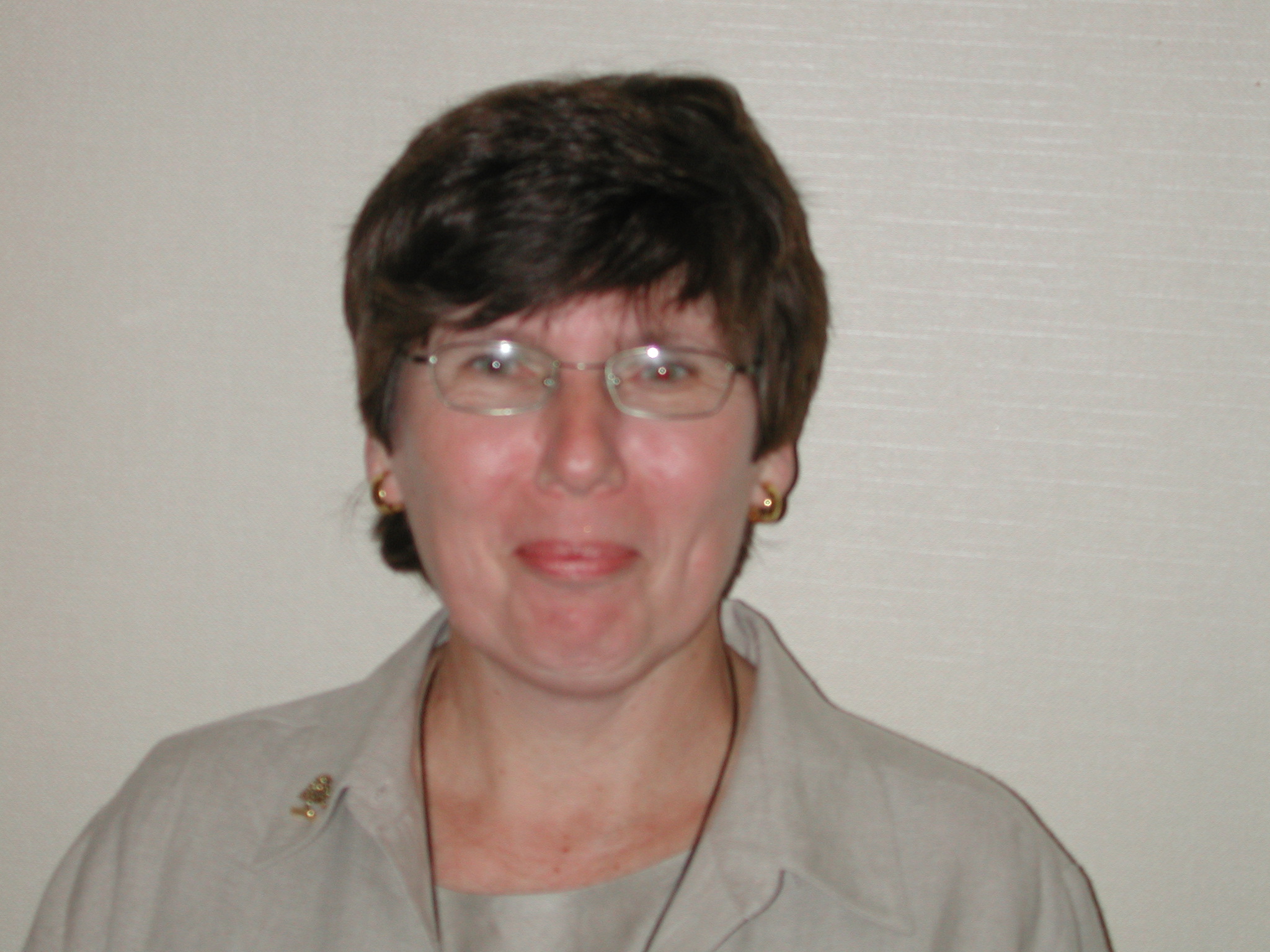
"Pauline Muth, 07/03/2002 (Photo courtesy of Alan Walker, 05/11/07) (Sept 24, 2022 Facebook post by Hiram Macias; Pauline Muth's Facebook page, 09/24/22; "Bonsai Confidential - Pauline Muth - PFM Bonsai Studios," Peace Love Bonsai, March 1, 2021; "Pauline Muth," American Bonsai Ceramics; "EP11: Pauline Muth - PMF Bonsai Studio," Bonsai in Conversation, December 19, 2020; "Bonsai talk with Pauline Muth," The Bonsai Supply, Nov. 10, 2021; "Page 72 - Demo," BCI; The Indices 2004 - ABS; Video posted by Brandon Herwick on Mark Arpag FB post shared on second anniversary of Pauline's passing.] SEE ALSO: Apr 8 |
||||
| 25 |
1985 -- The First Chinese National Penjing Exhibition began today in Shanghai and would run through October 20. [A penjing composition
by Yangzhao master Qingquan Zhao, "Painting With Eight Horses," would take first prize at this judged exhibition.]
(Karin Albert personal e-mail to RJB, July 15, 2002; Hu, Yunhua Chinese Penjing, Miniature Trees and Landscapes
(Portland, OR: Timber Press; ©1987 Wan Li Books Co., Ltd., Hong Kong), pg. 59) SEE ALSO: Jan 27
2015 -- The First Artisans Cup exhibition opened today and would run through the 27th. It was held at The Portland Art Museum. (Some still photos and a short video by BonsaiEmpire from opening night can be found here. And, as with most prominent exhibitions, professional photos of each tree/composition were taken before the show opened for a later album.) Internationally reknown teachers and artists David DeGroot, Colin Lewis, Boon Manakitivipart, Walter Pall, and Peter Warren were the judges to evaluate the trees and bestow honor to the top three most innovative and skillfully crafted examples of American Bonsai. All of the panel discussions sold out ahead of time and people were coming from around the world. The event also featured 22 vendors, select artisans and craftsmen who are creating distinctive supporting elements such as ceramics, woodwork, tools, and more. (The Artisans Cup Jurors -- and founders -- Ryan Neil and Michael Hagedorn, spent hours and hours reviewing over 300 submissions entered between April 1 and June 1. The applications consisted of four photos of each submitted bonsai, a brief essay of the display decisions, pot information, and accent information. The trees were selected by June 20 to be displayed at the inaugural exhibition. Those who submitted were notified privately on June 30th of the Jury's decision, and the accepted exhibitors were publicly announced on July 1st. The selected list was made up of 55 artists (including the Huntington Library Bonsai Collection and Pacific Bonsai Museum) presenting 70 trees or compositions. There were also six alternates chosen.) [The First place winner would be Randy Knight's 650-year-old collected Rocky Mountain Juniper (#32, in training for five years, in an antique Chinese container on a stand by Austin Heitzman of the U.S.), taking the $10,000 prize; the Second place prize of $5,000 would go to Tim Priest's 300-year-old collected Sierra Juniper (#52, in training for five years, in a Chinese container on a Japanese stand); and it would end up that the Third place would be a tie with both entries being awarded a certificate, plaque, and $3,000 each: Amy Blanton's 450-year-old collected Rocky Mountain Juniper (#4, in training for 4 years, with Mike Blanton in memoriam, in a modern Chinese container on a stand by Jason Eider of the U.S.) and Konnor Jenson's 40 to 50-year-old imported Japanese White Pine (#27, in training for an unknown period, in a modern Chinese container on a stand by Austin Heitzman of the U.S.) The Best Accent Plant would be Randy Knight's Companion Plant with Coastal Redwood. There would also be a People's Choice Award. The printed event program can now be found here. And a blog article by Eric Schrader about the voting can be found here.] (The Artisans Cup was originally scheduled to take place in October 2013, but in April 2013 -- after some fourteen months of research and planning and with much enthusiastic support already gathered -- the decision was made to postpone it. A 2014 presentation was skipped out of deference to the National Show to be held in September in Rochester, NY.) The ultimate goal is to elevate bonsai into a contemporary art form worthy of museums; to create a professional, modern bonsai culture in America, one that could support artists at every level, from the people who find the trees in the wild to the ceramicists who make the pots. Ryan and his wife Chelsea booked the Portland Art Museum, and then cold-called Portland's internationally recognized architecture firm Skylab, which signed on to create a modular exhibition to display the trees and help in the effort to make bonsai cool for a new generation. The exhibition room was almost completely dark, with only two small spotlights on each tree. Per a detailed article posted on Facebook two weeks after the show, "The clinical and hyper-critical nature of a traditional bonsai exhibition was lost and intimacy was created. The light, the shadow, the way in which the staging was arranged, the limited number of visitors allowed in at one time all created an intimacy that was unique and yet strangely familiar... Viewing each tree from the slightly skewed physical perspective in the exhibition, as they were arranged not lined up one after the other, but at angles... This is something that used to be done way back in the day, if you look at early Kokufu books and Meiji/Taisho (pre 1926) displays... The layout of the staging allowed the viewer to look at the trees from a number of different angles, interact with them from the side and not just the front... Is that not the purpose of a bonsai exhibition?" (Saruyama Bonsai's full Facebook posting about display is here.) ("We have a lot more youth and less tradition," Ryan said in one of several advance news reports about the event. (A website, http://www.theartisanscup.com/, was set up after the start of 2015.) "We've got a pretty keen eye for innovation. And our environment is wild and untamed, and our material reflects that." In addition to Skylab Architects there were 8 other collaborators, 16 corporate sponsors, and 50 donors. Before the show opened there already was an invitation to stage the Artisans Cup in Sydney, Australia in 2020. Long-term plans are for the 2025 show to be in New York at a location such as MOMA or the Guggenheim or the Whitney.) 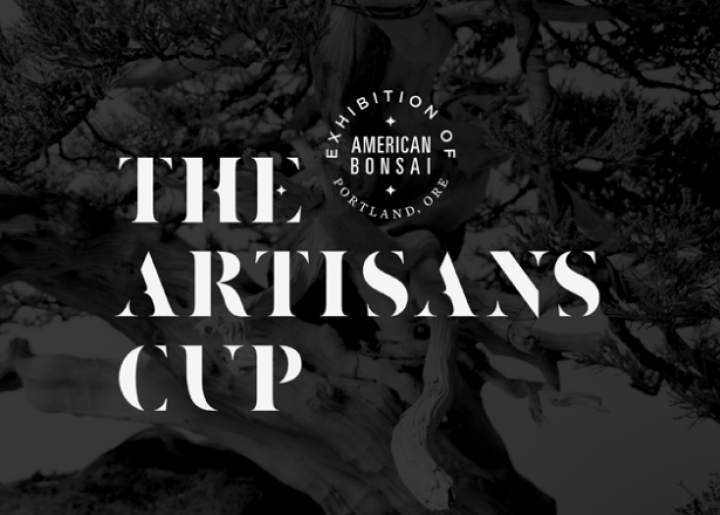
(http://www.theartisanscup.com/; Ryan Neil Facebook posting on June 20, 2015; Kimura Bonsai and Landscape Nursery's Facebook posting on July 1; Louise Leister Facebook posting on Sept 26; Scott, Aaron, "Is Portland The Epicenter Of A New American Bonsai Movement?," OPB FM, Sept 19, 2015; "Artisans Cup postponed until September 2015," Crataegus Bonsai blog, May 1, 2013; "Artisans Cup website is here!," Crataegus Bonsai blog, Feb 17, 2015; "Artisans Cup submissions are open," Crataegus Bonsai blog, Apr 6, 2015; Schoech, Wayne, "Artisans Cup - Two Years Late & Right on Time ," BonsaiBark blog, Nov 23, 2014; "Third Place Tie Announced for The Artisans Cup," Crataegus Bonsai blog, Oct 3, 2015; "The Results Are In!," The Artisans Cup, Sept 29, 2015; "Dan Robinson, Bonsai Pioneer," BonsaiBark blog, Oct 3, 2015; "Making a statement about Bonsai, American or otherwise," Saruyama Bonsai's Oct 12, 2015 Facebook post, https://www.facebook.com/permalink.php?story_fbid=918211291606994&id=314362778658518&fref=nf&pnref=story) SEE ALSO: Apr 25, Jul 20, Oct, 7, Nov 21 |
||||
| 26 |
1928 -- Bigbrit "Big" Almström was born in Stockhlm, Sweden. [She would go
on to be considered the mother of Bonsai in Sweden.]
(Facebook
post, Jan. 28, 2023 from Bigbrit's family; "Svenska
BonsaiSallskapet Show and a visit to Bigbrit Ashley Almström," Bonsai & Yamadori from Tony
Tickle, March 27, 2019) SEE ALSO: Jan 28
1981 -- The two day first-ever National Bonsai Convention of the newly formed Federation of British Bonsai Societies (FoBBS) convened at Keele University, Straffordshire, about forty miles south of Manchester. Over 250 registrants from most of the then twenty-eight listed clubs in Wales, Scotland and England participated. Peter Adams and Dan Barton were among the lecturer-demonstrators. ("Notes From the First British Bonsai Convention" by Robert Burgess, Bonsai, BCI, January/February 1982, pg. 12; "The Start of a New British Tradition" by Lucille Lee Roberts, Bonsai Magazine, BCI, April 1982, pp. 86-86.) SEE ALSO: Jul 23, Sep 1, Oct 8 2010 -- Actress, book artist, painter, and bonsai artist Gloria Stuart died at age 100 of complications from five years of lung cancer at her West Los Angeles home. (McLellan, Dennis "Actress Gloria Stuart, the elder Rose in 'Titanic,' dies at 100," Los Angeles Times, Sept. 27, 2010, http://www.latimes.com/news/la-stuartobit27-m,0,6570652.story) SEE ALSO: Jul 4 and this tributeby Cheryl Manning. |
||||
| 27 | 1918 -- Bob Kato was born. [He would go on to become a respected teacher in the San Francisco, CA area.] (https://sortedbyname.com/letter_k/k107339.html) SEE ALSO: Sep 14 | ||||
| 28 |
1929 -- Max Braverman was born in Far Rockaway, New York, a part of the borough of
Queens. [He would go on to have a varied life which included, among other achievements, a PhD
in Zoology/Physiology from University of Illinois (1955-60); post-doctoral fellow with culture of mammalian
cells in Stockholm, Sweden (1961-62); consultant to research unit for radiation therapy at Mercy Hospital,
Pittsburgh, PA (1966-70); collaborator on computer applications of research at Los Alamos Scientific Lab,
NM (1967-71); and consultant on teaching science in elementary schools for Mountainview Center for
Environmental Education in Boulder, CO (1970-77). Max would become interested in clay in the mid-1960s
and become a "functional potter" as opposed to an "artist." While in Japan to present a paper before
an international congress on hydroid development, he would come upon books regarding the virtues of the peasant
tradition in both Japanese and Chinese crafts. These would change his life. Returning home he would
become self-employed as a potter in Taos, NM (1971-77) and Hope, NJ (1977-86). Then he'd spend six weeks
with his family in China and Taiwan in the early-80s studying where the best examples of the ceramic arts were
still produced by hand. It would be in New Jersey where his sculptor wife Kate Bowditch and he were
introduced to bonsai, spending a day early on picking Chase Rosade's brains. Inevitably he would start
experimenting with bonsai containers, first for his own use and then for sale. At a conference in Seattle
they would find their hand-made bonsai pots happily received, and thus be encouraged to move West. Continuing
to throw on the wheel, he would be proprietor of the Pine Garden Bonsai
Nursery in Arlington, WA (1986-1998). With his wife he would craft entertaining and informative book
reviews for the ABS Journal (in at least 6 issues, Spring 1991-Winter 1992). In the early days of the
Internet Bonsai Club, Max would be among those who attempted to gather regional data for posting to the list so
folks beyond his area would be informed of activities. He would post and host the first suiseki collecting
trip to which any potential registrant was invited (ten showed up Aug. 92), and would offer the first suiseki for
sale on the Internet. Difficulties with maintaining thousands of starter plants for five years before they
were large enough to market, a damaging winter storm, and realization that the few people who cherished hand-made
containers weren't numerous enough to keep even the less than a dozen bonsai potters in the US alive all strained
both the business and marriage to the breaking point. Max then would move on to Xiamen, China. Located
halfway between Shanghai and Hong Kong, this base would allow him trips to Bali and Indonesia while working on
other projects. (Shortly after his move to China his entire collection of pots with Kate's trees would be
stolen. Other pots of his creation would continue to be prized.) In early June 2002 he would have a
slight heart attack, and the following month be moved back to Washington state.]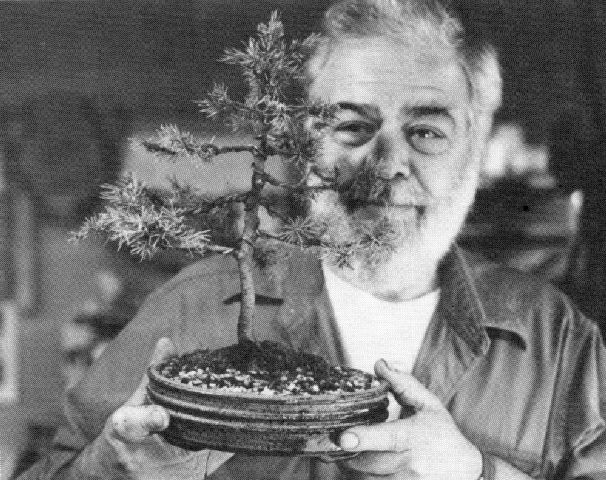
"Here [Max Braverman] displays a small, collected alpine
hemlock in a glazed and fired example of this [step-by-step demonstrated] container. The turquoise glaze reinforces the delicate blue-green of the tree's needles." (Bonsai Journal, ABS, Winter 1989, pg. 21, Fig. 16) 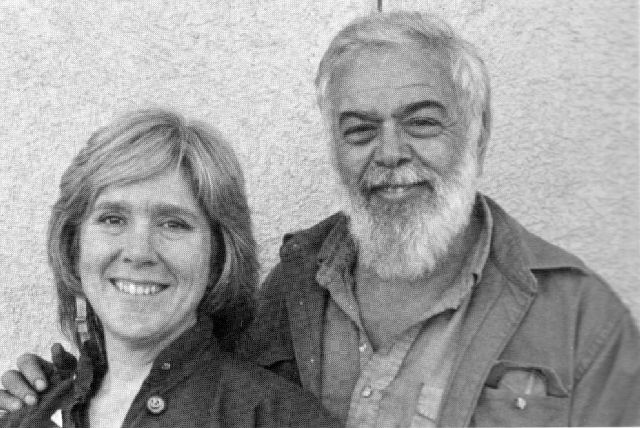
Kate Bowditch and Max Braverman.
(Bonsai Journal, ABS, Spring 1991, pg. 28) (Personal e-mails to RJB, June 6, 2002 and Jan. 26, 2003; E-mails between Max and Chris Cochrane, March 8-9, 2002, forwarded to RJB the following day, © Max Braverman 2002, reprinted with permission; "Searching For the Perfect Stone" by Max Braverman and George Heffelfinger, Bonsai Journal, ABS, Spring 1993, Vol. 27, No. 1, pg. 17) SEE ALSO: Sept 24 2008 -- The National Bonsai and Penjing Collection of Australia opened in a temporary location in Commonwealth Park in central Canberra. This first, national, and permanent collection of bonsai in Australia at Stage One consists of some 30-50 or so trees that have either been donated or loaned to it. For public enjoyment and education, on display is an initially small collection of high-quality bonsai and penjing representing the diversity of styles amongst Australian artists. It is the first of the '100 Gardens' in the Australian Capital Territory's major "Canberra International Arboretum and Gardens" project. [It will be funded by the ACT Government. It will remain in Commonwealth Park until its permanent Stage One home is constructed on the Event Terrace at the Arboretum, probably by 2013, the centenary year of the establishment of Canberra. In Stage Two, it will have a much larger facility, with spaces for more trees, education, library and display of bonsai paraphernalia dependent on the raising of private funds. Stage Two has been allocated a site near the visitor facilities when it is needed.] ("Who We Are," http://www.cbs.org.au/NBPCA/Who%20we%20are.htm, "Goals," http://www.cbs.org.au/NBPCA/Goals.htm.) SEE ALSO: Feb 1 2024 -- Ficus bonsai master Jerry Meislik passed away at his home in Montana after a three-and-a-half-year illness. (FB posting by Ed Trout of a Michael Field earlier posting on October 2, 2024. Date corrected by Marty Klein's Oct 9 FB posting of Jerry's obituary.) SEE ALSO: Nov 21 |
||||
| 29 |
2004 -- Daniel Joseph Chiplis died of chronic lymphocytic leukemia at age 51 at his
home in Silver Springs, MD. (A native of Indianapolis, Dan's interest in bonsai began at age 17 when
he saw his first trees at Max Mendel's Bonsai Gardens on the southeast side of Indy. Recognizing the youth's
fascination, Max made his bonsai library available to Dan and taught him the principles
of bonsai art and culture. Later, while a horticulture student at Purdue University,
Dan and several student friends formed the Purdue Bonsai Club with Max as their teacher. Then came
forestry, orchard and arboretum work followed by graduate study in
horticulture at Ohio State University under plant physiologist Dr. Makoto Kawase. Dan
underwent bonsai training in Omiya, Japan, and also studied with bonsai masters
John Y. Naka in California and
Yuji Yoshimura in New York. Dan shared his expertise on bonsai as
a guest speaker at national and regional gatherings as well as in a column in BCI's Bonsai Magazine
called "Seasonal Reminders." He also taught a class called "Introductory Bonsai" at the
U.S. Department of Agriculture Graduate School.
He worked for the National Arboretum in Washington, D.C. from 1984 to 1998, serving as assistant curator of the
National Bonsai and Penjing
Museum. In 1998, he transferred to the Smithsonian Institution, where until
his retirement last October he helped plan the landscaping of the grounds of the new
National Museum of the American
Indian. In recent years, Dan participated in and supported "Plunge for Patients,"
a fundraiser benefiting the Johns Hopkins Patient and Family Fund.)
2005 -- Charles B. "Todd" Harnett, 75, of Sevierville, TN died at University of Tennessee Hospital. (He graduated from Lanphier High School of Springfield, IL in 1948. A veteran of the U.S. Navy and U.S. Air Force, he was a writer and horticulturist and owned Bonsai East nursery in Wears Valley, TN. His book, Secrets of Bonsai Miniature Trees: Their Care and Maintenance, was first published in 1989. He had a reputation for creating healthy and attractive bonsai for many years, and he enjoyed hearing from his many satisfied, return customers about their beloved bonsai.) ("Memorials," LanHiOnline.com, http://www.lanhionline.com/Lanphier%20Memorials.txt; "Comments regarding Bonsai East," Dave's Garden, http://davesgarden.com/products/gwd/comments.php?compid=4216&type=2.) |
||||
| 30 |
1907 -- Max Mendel was born in Germany. [He would learn the floral design trade
there before coming to the United States on Christmas 1926. His first brush with Oriental art would be
through making little dish gardens with Japanese figurines in the 1930s. Max and his wife Lois would be
introduced to bonsai while visiting the famous D. Hill Nursery in
Dundee, Illinois, a Chicago suburb in the late 1940s. His nursery, Mendel Gardens, would be
established out to the far southeast side of Indianapolis. Max would then be president of the
Indianapolis Bonsai Club in 1972, 1984 and 1985, and he would mentor
several members of the IBC over the years. Still with a heavy German accent, Max would lecture on the
subject of bonsai at horticulture symposiums at Indiana University and
Purdue University and numerous high schools and garden clubs in central
Indiana. Due to failing health in the mid-1990s he would disperse his collection.]
(SSN Master File by Number;
Langschied, Jim "Bonsai: the living masterpiece," Kokomo Tribune, May 13, 1986, pg. 9,
http://newspaperarchive.com/kokomo-tribune/1986-05-13/page-9/;
Turley, Michael "Looking Back on a Decade," Indianapolis Bonsai Club Newsletter, Aug. 2009, pg. 1,
http://www.indybonsai.org/_wp_scripts/newsletters/Newsletter_0809c.pdf)
SEE ALSO: Jan 25, Nov 20
1988 -- The Chinese Penjing Collection at the U.S. National Arboretum in Washington, D.C. was dedicated and put on public display. It includes over thirty specimens by Dr. Yee-sun Wu, Mr. Shu-ying and others of Hong Kong which had been donated two years earlier. ( International Bonsai, 1989/No. 2, pg. 22) SEE ALSO: Mar 27, May 2 |
